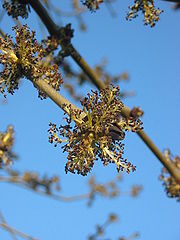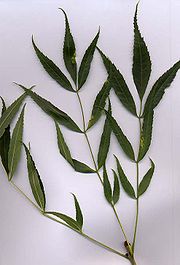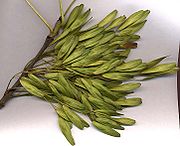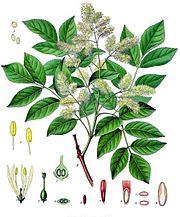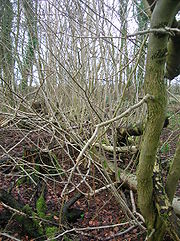
Fraxinus
Background to the schools Wikipedia
The articles in this Schools selection have been arranged by curriculum topic thanks to SOS Children volunteers. SOS Children is the world's largest charity giving orphaned and abandoned children the chance of family life.
| Fraxinus | |
|---|---|
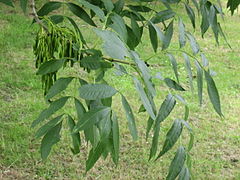 |
|
| European Ash (Fraxinus excelsior) | |
| Scientific classification | |
| Kingdom: | Plantae |
| Division: | Magnoliophyta |
| Class: | Magnoliopsida |
| Order: | Lamiales |
| Family: | OleaceaeASS |
| Genus: | Fraxinus Tourn. ex L. |
| Species | |
|
See text |
|
An ash can be any of four different tree genera from four very distinct families (see end of page for disambiguation), but originally and most commonly refers to trees of the genus Fraxinus (from Latin "ash tree") in the olive family Oleaceae. The ashes are usually medium to large trees, mostly deciduous though a few subtropical species are evergreen. The leaves are opposite (rarely in whorls of three), and mostly pinnately-compound, simple in a few species. The seeds, popularly known as keys, are a type of fruit known as a samara. The tree's common English name goes back to the Old English æsc, a word also routinely used in Old English documents to refer to spears made of ash wood.
Selected species
- Ashes of eastern North America
- Fraxinus americana White Ash (also called cane ash, Biltmore ash or Biltmore white ash)
- Fraxinus caroliniana Water Ash
- Fraxinus nigra Black Ash (also called swamp ash, basket ash, brown ash, hoop ash, or water ash)
- Fraxinus pennsylvanica Green Ash (also called red ash, swamp ash or water ash)
- Fraxinus profunda (syn. F. tomentosa) Pumpkin Ash (also called red ash)
- Fraxinus quadrangulata Blue Ash
- Ashes of western and southwestern North America
- Fraxinus anomala Single-leaf Ash
- Fraxinus cuspidata Fragrant Ash
- Fraxinus dipetala California Ash or Two-petal Ash
- Fraxinus dubia
- Fraxinus gooddingii Goodding's Ash
- Fraxinus greggii Gregg's Ash
- Fraxinus latifolia Oregon Ash
- Fraxinus lowellii Lowell Ash
- Fraxinus papillosa Chihuahua Ash
- Fraxinus purpusii
- Fraxinus rufescens
- Fraxinus texensis Mountain Ash or Texas Ash
- Fraxinus uhdei Shamel Ash or Tropical Ash
- Fraxinus velutina Velvet Ash
- Fraxinus angustifolia Narrow-leafed Ash
- Fraxinus angustifolia var. oxycarpa (syn. F. oxycarpa) Caucasian Ash
- Fraxinus excelsior European Ash
- Fraxinus holotricha
- Fraxinus ornus Manna Ash or Flowering Ash
- Fraxinus pallisiae Pallis' Ash
- Ashes of the Eastern Palearctic (central & eastern Asia)
- Fraxinus apertisquamifera
- Fraxinus baroniana
- Fraxinus bungeana Bunge's Ash
- Fraxinus chinensis Chinese Ash or Korean Ash
- Fraxinus chiisanensis
- Fraxinus floribunda Himalayan Manna Ash
- Fraxinus griffithii Griffith's Ash
- Fraxinus hubeiensis
- Fraxinus japonica Japanese Ash
- Fraxinus lanuginosa
- Fraxinus longicuspis
- Fraxinus malacophylla
- Fraxinus mandschurica Manchurian Ash
- Fraxinus mariesii Chinese Flowering Ash
- Fraxinus micrantha
- Fraxinus paxiana
- Fraxinus platypoda
- Fraxinus raibocarpa
- Fraxinus sieboldiana Japanese Flowering Ash
- Fraxinus spaethiana Späth's Ash
- Fraxinus trifoliata
- Fraxinus xanthoxyloides Afghan Ash
Threats
The emerald ash borer Agrilus planipennis, a wood-boring beetle accidentally introduced to North America from eastern Asia with ash wood products circa 1998, has killed millions of trees in the Midwestern US and adjacent Ontario, and some isolated smaller areas on eastern North America. It threatens some 7 billion ash trees in North America. The public is being cautioned not to transport unfinished wood products, such as firewood, to slow the spread of this insect pest.
Ash is also used as a food plant by the larvae of some Lepidoptera species - see list of Lepidoptera that feed on ashes.
Uses
The wood is hard (a hardwood), tough and very strong but elastic, extensively used for making bows, tool handles, quality wooden baseball bats, hurley sticks and other uses demanding high strength and resilience. It is also often used as material for guitar bodies, known for its bright, cutting tone and sustaining quality, as well as snooker cues. Ash veneers are extensively used in office furniture. It also makes excellent firewood. The two most economically important species for wood production are White Ash in eastern North America, and European Ash in Europe. The Green Ash is widely planted as a street tree in the United States. The inner bark of the Blue Ash has been used as a source for a blue dye. The cortex (bark) of Fraxinus rhynchophylla HANCE (Chinese: Ku li bai la shu), Fraxinus chinensis ROXB. (Chinese: Bai la shu), Fraxinus szaboana English (Chinese: Jian ye bai la shu) and Fraxinus stylosa English (Chinese: su zhu bai la shu)are used in Traditional Chinese Medicine (TCM) for diarrhea, dysenteric disorder, and vaginal discharge. It is also good for the eyes where there is symptoms of redness, swelling, and pain. The dosage is 6-12 grams.
Cultural aspects
In Norse mythology, the World Tree Yggdrasil is commonly held to be an ash tree, and the first man, Ask, was formed from an ash tree (the first woman was made from elm). Elsewhere in Europe, snakes were said to be repelled by ash leaves or a circle drawn by an ash branch. Irish folklore claims that shadows from an ash tree would damage crops. In Cheshire, it is said that ash could be used to cure warts or rickets. See also the letter ash.
In Greek mythology, the Meliai were nymphs of the ash, perhaps specifically of the Manna Ash (Fraxinus ornus), as dryads were nymphs of the oak. Many echoes of archaic Hellene rites and myth involve ash trees.
The ash exudes a sugary substance that, it has been suggested, was fermented to create the Norse "Mead of Inspiration."

